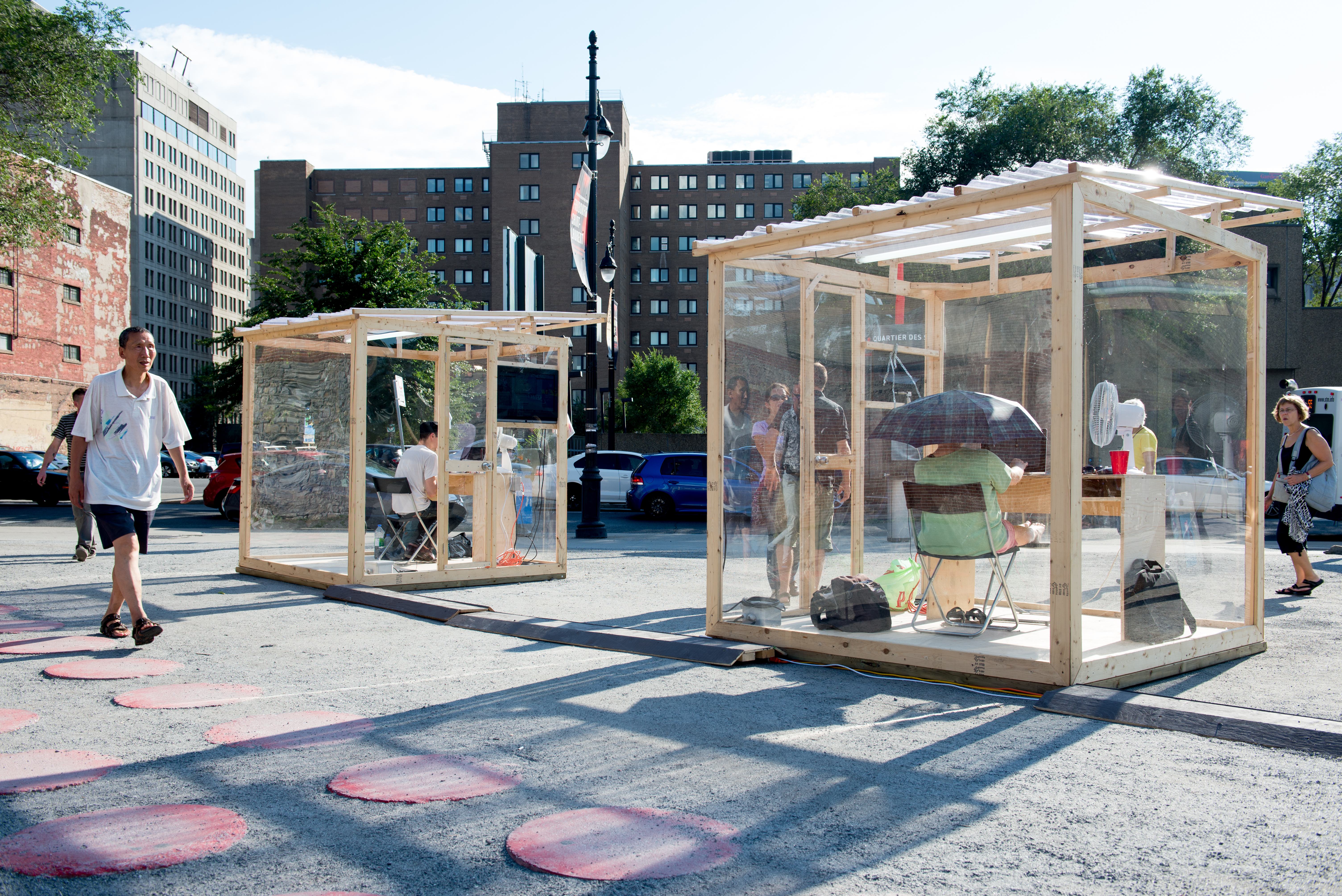Those entering the St. Laurent metro station last weekend would have seen a peculiar sight outside: two artists sitting in plexiglass cubes, their eyes focused on computer screens. The people in question were Quebec performance artists karen elaine spencer and Adam Bergeron, in the middle of performing their new work, Bloggers in Captivity. The piece saw the two artists bubbled on St. Laurent for three consecutive days, while writing online blog posts about their experience.
karen elaine spencer, who graduated from the Nova Scotia College of Art and Design and now lives and works in Montreal, has been a performance artist for decades, creating work that, according to a press release, questions “the hierarchy inherent in our values.” Adam Bergeron, who is currently a Masters student at Université Laval, often incorporates paintings into his performance art, examining norms of taste and style. Bloggers in Captivity includes both the artists’ focuses, and directs them toward the social and political implications of isolation in a digital world, with the Marx-esque motto “alienated from all countries, unite!”
The “in captivity” conceit of the piece is, in a way, a red herring. Physically, the two artists were not completely isolated. The clear glass allowed the audience to see the artists typing on their laptops, sitting, and eating lunch. On a wall of each cube, a screen showed in real time what the artists were blogging, giving the audience insight into the artists’ thoughts and feelings as they occurred. Some passers by asked the artists if they could take photos, but for the most part, Montrealers were unphased by the spectacle and more concerned with getting to the train on time.
The performance itself was rather anticlimactic, even upon multiple visits. The plexiglass barrier made it difficult to engage the artists directly, and the artists mostly avoided eye contact with the audience. Perhaps their goal was, in fact, not to attract attention.
While the artists did not generate much attention on the streets, the online portion of their performance has attracted numerous comments. Rather than focusing on the physical alienation their “captivity” seemed designed to emulate, Bergeron and spencer centred their attention on other more political definitions of “alienation.”
In their blog posts, the two artists argued that it is not the internet that causes modern alienation, but neoliberal capitalism. Bergeron expanded on the artists’ slogan, itself a reference to The Communist Manifesto, in a post criticizing Margaret Thatcher and Ronald Reagan. “For one to believe in a sacred uniqueness of individuals is [a] risk for a political paralysis, even if it is sold as a ‘higher’ form of empowerment,” he states, “it remains that we have to unite our individual strength if we want to knit some kind of social scarf for us to protect each other.” spencer, on the other hand, concentrated her posts on immigration, examining the meaning and etymology of the word “alienated” and connecting it to the term “illegal alien.”
In addition to the political core of Bloggers in Captivity, Bergeron’s posts about his own feelings of alienation, usually accompanied by his own paintings, are poetically candid and add an engaging element to the piece that could not be experienced outside the metro. spencer’s posts, on the other hand, showed an enjoyable dry wit: as rain began to pour on the installation, she posted Buddy Guy’s “Feels Like Rain,” and earlier remarked on the difficulty of finding a picture of a space alien with hair.
Ultimately, there is a limit to the public or political impact that can be made by a project like Bloggers in Captivity. Most of the people heading into or passing by the St. Laurent metro passed by the exhibition entirely.
However, the artists’ location helped to further spencer’s goal of breaking down the barrier between artistic practice and daily life, and despite the lack of attention, the audience was likely larger than it would have been at an art gallery or museum. Moreover, performing outside the metro, a location so often associated with transport to and from work, offered the possibility of spencer and Bergeron’s message reaching the workers who are arguably the most affected by alienation.
Due to the fact that audience members have to find online posts to understand the project, Bloggers in Captivity is ironically too inaccessible to be a connecting artistic experience. It remains, however, a useful piece, demonstrating that both art and politics are simultaneously individual and universal experiences.

